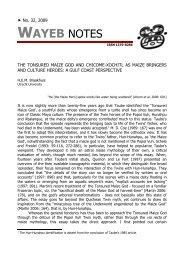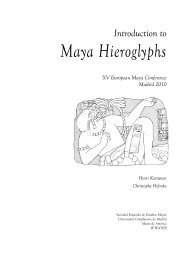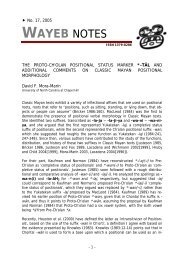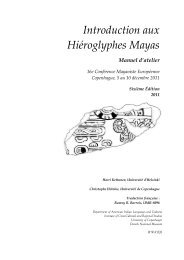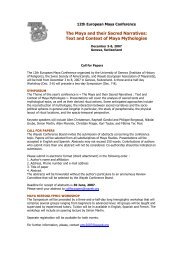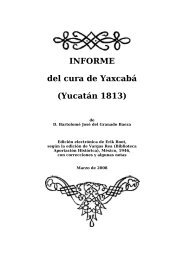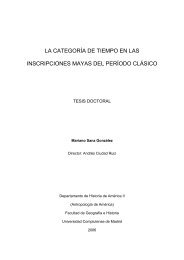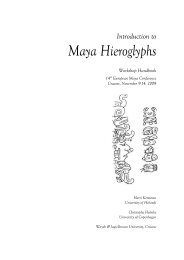Introduction to Maya Hieroglyphs - Wayeb
Introduction to Maya Hieroglyphs - Wayeb
Introduction to Maya Hieroglyphs - Wayeb
Create successful ePaper yourself
Turn your PDF publications into a flip-book with our unique Google optimized e-Paper software.
Kettunen & Helmke 2011<br />
Glossary of Linguistic Terminology<br />
syllable<br />
A minimal unit of organization for a sequence of sounds. Syllable usually comprises of a nucleus (typically a<br />
VOWEL or vowels) <strong>to</strong>gether with optional initial and/or final margins (typically CONSONANTS). Symbols C<br />
(consonant) and V (vowel) are used <strong>to</strong> express syllabic structures: e.g. the Classic <strong>Maya</strong> word “ch’ahom” would be<br />
transliterated using this notation as: CV.CVC (ch’a-hom). In contrast <strong>to</strong> standard method in linguistics, Classic<br />
<strong>Maya</strong> words are transliterated syllabically on the basis of GRAPHEMIC syllables, i.e. the distinction is made between<br />
pronounced syllables and graphemic syllables. The word ch’ahom is thus divided in<strong>to</strong> three graphemic syllables (or<br />
syllabograms): ch’a-ho-ma, and it can be indicated using both sets of syllabic notations (graphemic and<br />
pronounced): CV.CV.CV CV.CVC (or: CV-CV-CV CVCVC).<br />
syncope<br />
The deletion of a segment in a word. For example, the Classic <strong>Maya</strong> INTRANSITIVE verb “<strong>to</strong> dance” is derived from<br />
the noun ahk’ot “dance” <strong>to</strong> produce ahk’taj < ahk’ot + -aj (the phoneme /o/ has thus been syncopated).<br />
syntax<br />
The study of the rules by which words are combined <strong>to</strong> form phrases, clauses, and sentences.<br />
tense<br />
A grammatical category, feature, or expression of the time of a situation relative <strong>to</strong> some other time (usually<br />
associated with verbs). Tense is traditionally classified in<strong>to</strong> past, present, and future. It is still debatable whether<br />
tense (or ASPECT) is present in the <strong>Maya</strong> hieroglyphic writing.<br />
<strong>to</strong>ponym<br />
A <strong>to</strong>ponym is a NOUN (or a noun phrase) which is assigned <strong>to</strong> a geographic location. For example, Belize, Pook’s<br />
Hill, Tikal, Leiden, Shite Creek, Koiransellaisenoja, Naughty Girl Meadow, Qaanaaq, Nunathloogagamiutbingoi,<br />
Taumatawhakatangihangakoauauotamateaturipukakapikimaungahoronukupokaiwhenuakitanatahu, El Pueblo de Nuestra<br />
Señora la Reina de los Angeles de Porciúncula, and Ii are <strong>to</strong>ponyms.<br />
transitive<br />
A verb or a verbal structure which has or requires a direct OBJECT.<br />
velar<br />
A sound produced with a constriction formed by raising the back of the <strong>to</strong>ngue (dorsum) <strong>to</strong>wards the soft palate<br />
(velum). There are two clear velar sounds in the Classic <strong>Maya</strong>: [k] and [k’], and one sound that is either velar or<br />
uvular: [x] (written graphemically as and pronounced as in the Spanish name “Juan”) – not <strong>to</strong> be confused<br />
with the GRAPHEME .<br />
verb<br />
A word that designates a situation, an event, or an action. Verbs can typically be inflected in, e.g., person, aspect,<br />
voice, and tense.<br />
voice<br />
A grammatical system of INFLECTIONS of a verb <strong>to</strong> indicate the relation of the SUBJECT of the VERB <strong>to</strong> the action<br />
which the verb expresses. There are four voices present in the Classic <strong>Maya</strong> language: ACTIVE, PASSIVE,<br />
mediopassive (or middle voice), and antipassive. For more information, turn in<strong>to</strong> the grammar section on page<br />
66.<br />
143/154



